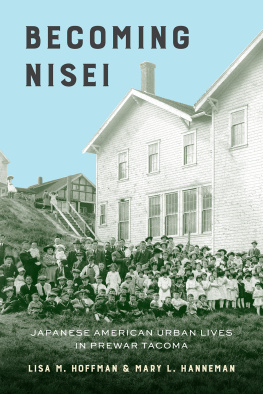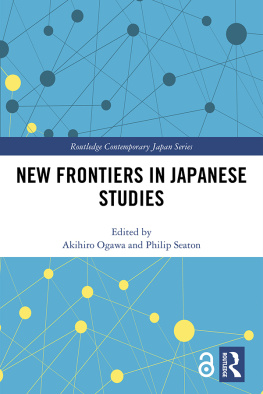PACIFIC PIONEERS
The Asian American Experience
Series Editor
Roger Daniels, University of Cincinnati
A list of books in the series appears
at the end of this book.
Pacific
Pioneers
JAPANESE
JOURNEYS TO
AMERICA AND
HAWAII,
185080
JOHN E. VAN SANT
Foreword by Roger Daniels
UNIVERSITY OF ILLINOIS PRESS
URBANA, CHICAGO & SPRINGFIELD
2000 by the Board of Trustees of the University of Illinois
All rights reserved
The Library of Congress cataloged the cloth edition as follows:
Van Sant, John E., 1958
Pacific pioneers : Japanese journeys to America and Hawaii, 185080 / John E.
Van Sant ; foreword by Roger Daniels.
p. cm. (The Asian American experience)
Includes bibliographical references (p. ) and index.
ISBN 978-0-252-02560-0 (alk. paper)
I. Title. II. Series. 1. Japanese AmericansHistory19th century.
2. Japanese AmericansHawaiiHistory19th century.
3. ImmigrantsUnited StatesHistory19th century.
4. ImmigrantsHawaiiHistory19th century.
5. United StatesEmigration and immigrationHistory19th century.
6. JapanEmigration and immigrationHistory19th century.
7. HawaiiEmigration and immigrationHistory19th century.
8. United StatesRelationsJapan.
9. JapanRelationsUnited States.
E184.J3V3 2000
304.87305209034dc21 99-006829
CIP
Paperback ISBN 978-0-252-08490-4
To my parents,
John and Eunice Van Sant
CONTENTS
Although the mass immigration of Japanese to the United States and Hawaii dates from the 1890s, scattered individuals and small groups began pioneering the Pacific crossing in the 1840s. The existence of these forerunnersperhaps 900 all told to the United States and a couple of hundred more to the Kingdom of Hawaiihas long been known to scholars, but it is the particular virtue of John Van Sants Pacific Pioneers that he not only weaves their disconnected stories into a meaningful narrative but also uses their varied experiences to explore the beginnings of trans-Pacific cultural relationships, which would loom so large and fateful in the twentieth century. The thousand-odd travelers included castaways, students, government officials, political exiles, indentured laborers, and businessmen. Their trans-Pacific sojourns took them to a variety of sites: San Francisco; Washington, D.C.; Rutgers University in New Brunswick, New Jersey; upstate New York; Amherst, Massachusetts; Hawaiian plantations, and a short-lived colony at Gold Hill near Sacramento, California. Most returned to Japan, although a few became permanent residents.
Since the time of Marcus Lee Hansen, who began to publish in the 1920s, historians of migration have understood that the ideal positioning for such work is between the cultures that a given migration spans rather than either the launching pad or the target. Van Sant is particularly well equipped for this examination of what he calls transnational history. Raised and educated on the West Coast of the United States, he studied Japanese history and U.S. foreign relations for his doctorate and lived and worked in Japan for many years. He argues persuasively that the significance of these pioneer Japanese far transcends their precursor role.
Van Sant stresses three broad themes that form a subtext for his narrative. First of all, despite the tremendous cultural gulf between pre-Meiji and early Meiji Japan and the United States in the middle decades of the nineteenth century, most of these Japanese were able to function in both societies. Second, many of the Japanese sojourners shared a sense that the traditional Weltanschauung of Nippon was no longer appropriate to a nation upon whom the West had intruded. Some welcomed that intrusion and sought to instill certain Western valuesincluding, in some instances, Christianityinto a rapidly modernizing Japan. Third, sustained contact with Japanese in the United States inspired a few Americans not only to aid the education, formal and informal, of the visitors but also to try to assist in the transformation of Japan. Van Sant tells this complex story well: it is a small but significant part of both Japanese and American history and, relatively speaking, a larger section of Asian American history.
In addition, in a time when the debate about multiculturalism and its implications forms a significant part of American sociocultural discourse, it is good to be reminded that multiculturalism did not spring up only recently. Although the word is of relatively recent vintage, the fact of multiculturalism has been a too little noticed facet of American life since the Europeanled invasion of the Western Hemisphere began. The experiences of these Japanese travelers is but one part of a too much neglected history.
ACKNOWLEDGMENTS
Several colleagues, friends, family members, and institutions have assisted me during the years I spent researching, writing, and revising this study.
Masao Takeda of Aizu-Wakamatsu, Japan, and Henry Taketa of Sacramento, California, initially sparked my interest in the historical relationship between Aizu, Japan, and my hometown of Placerville, California, which soon evolved into this study of the frontier era of Japan-U.S. relations. I regret being unable to complete and publish this book before these fine gentlemen passed away. Moreover, they and several local historians in northern Japan and northern California have painstakingly gathered information that proved invaluable to this study, especially .
Glenn Anthony May, Jeffrey Hanes, and Stephen Kohl spent many hours reading earlier versions of this study while I was a doctoral candidate at the University of Oregon. Their comments, criticisms, and suggestions have made this a better and more coherent study than it otherwise would have been. Other friends and colleagues at the University of Oregon who assisted by reading and offering advice on sections of this study were Andrew Goble, Jeffrey Ostler, Bill Boyer, Sheila Broderick, Kim Loan Hill, Ellen Stroud, Stuart McElderry, Brett Walker, Richard Brown, and Leah Kirker.
The primary and secondary sources available at UCLAs University Research Library, especially its Department of Special Collections, were invaluable to this study. My thanks to Jeff Rankin and all of the curators and staff at UCLA who assisted me during the several months I spent using these resources. The Huntington Library in San Marino, California, held some important resources and awarded me a research fellowship that enabled me to complete a significant portion of this study. The interest displayed by Martin Ridge, Wilbur Jacobs, Robert Hine, and Hal Barron also aided me during the months I spent at the Huntington Library. The Griffis Collection at Rutgers University in New Jersey, curated by Ruth J. Simmons, was an important primary resource for early Japanese students in the United States. The Knight Library at the University of Oregon, including its prompt interlibrary loan service, was also quite helpful.
Others who assisted me along the way were Inez Veerkamp, Matt Sugerman, Wayne Patterson, Masanori Takeda, Chikao Koyama, Shinichi Kobayashi, Rith Crocker, Barbara Neisler, Loyd Neisler, Deborah Van Sant, and Roy Van Sant. Many thanks also to the University of Illinois Press for publishing this study.
Special thanks go to Roger Daniels. Despite his own constantly hectic schedule, Professor Danielss early interest in the book, his reading and editing of several complete drafts, and his well-deserved reputation as an eminent scholar of Asian American and immigration history have propelled this work to publication. Special thanks also go to Karen Hewitt, Executive Editor at the University of Illinois Press, who has spent many hours working with this manuscript.







